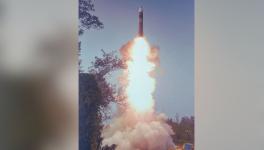Self-Reliance, a Strategic Necessity in the Time of COVID-19
It is now more than aweek since the hastily announced and ill-prepared nationwide 21-day lockdown was imposed by the Central government. The World Health Organisation (WHO) has long argued that lockdowns are not essential measures but, even if enforced, should be accompanied by other key measures, such as contact tracing, surveillance,extensive testing, quarantining of suspected cases and hospitalisation when needed, and taking action for adequate preparedness of the health care system for the expected explosive outbreak of COVID-19. As now seen in the US and Europe, lack of timely preparedness puts enormous strain on hospitals, doctors and the health system as a whole, as well as on the economy.
The Prime Minister and other officials have repeatedly asserted that the nationwide lockdown in India was “the only option left” to combat COVID-19, as if all other measures had been tried and exhausted, and that this three-week period was necessary to prepare for the coming epidemic.
As has long been pointed out by many public health experts and others, this is far from the truth. Despite knowing about the outbreak in China and possible global spread,and the first positive case in India in end-January, the government tookmany misstepsearly on. Lakhs of persons,including Indian nationals, were allowed into India from abroad even in March, with perfunctory screening at airports, restrictions onlyapplied to a slowly-expanded list of ports of embarkation, but without consideringwhere journeysoriginated.
Tens of thousands poured into India from the US, Europe and West Asia via Dubai,and from South East Asia, to which no restrictions were applied. When self-quarantine was imposed, there was little or no household surveillance, except in Kerala. As a result, many infected Indian and foreign nationals wandered all over the country. Even after the total ban on international flights on March 18, there has been no aggressive tracing, surveillance, and stringent quarantining, no “chasing the virus”, as the WHO chief put it, building up a massive chain of potential cases, clusters and hot spots.
Late preparedness leads to grave shortages.
Meanwhile, India took little or no measures to build up preparedness of its health system. There areonly limited hospital beds and ICUs(intensive care units) available,and even normal services are being suspended to keep beds free if the number of cases explodes.
Testing kits are in short supply, probably the major reason for the limited extent of testing in India,with only around 32 tests per million compared with about 5,800 in Germany and 7,600 in South Korea with relatively low infection rates and mortality. If India needs to scale-up testing, it may require more than 10 lakh test kits, around 20 times present availability.
There is also a serious shortage of ventilators, with many of the present stock of roughly 50,000 ventilators already being used in different hospitals. Going by the experience of Italy and the US, India may require 10-40 lakh units,as estimated by Johns Hopkins University and some Indian agencies, respectively.
There is also extremely low availability of sanitisers, masks, especially N95 masks, (panic among the public and a run on masks and sanitisersis making the shortage worse) and other personal protection equipment (PPE), such as coveralls, gowns, gloves, boots etc needed by doctorsand health workers. Several doctors and nurses have already been infected from exposure to positive cases, and protests have broken out about shortages and having to manage with makeshift gear like two-wheeler helmets, goggles and plastic sheets. The Government’s India Invest agency has estimated that India may require around 380 lakh masks and 62 lakh PPE units in the event of a major outbreak as witnessed elsewhere.
While almost two months to prepare was thus lost between mid-January and mid-March, serious efforts towards building up preparedness started in earnest just before or only after the lockdown was announced on March 24. Various efforts arebelatedlybeing taken to close this demand-supply gap. With global supply chains severely disrupted, and many countries hoarding supplies of test kits, PPE and other equipment, India cannot resort to its usual option of imports.
In this context, India has re-discovered the virtuesof the much-derided idea of self-reliance. However, having deliberately decimated the former backbone of Indian industry, namely the public sector, due to neo-liberal policy frameworks, India is now struggling to meet this huge demand.
The government has been forced to turn to public sector undertakings (PSUs), the only entities with the capacity to manufacture at scale. The much-touted private sector,which was supposed to replace and even surpass the public sector has, with only a few exceptions, been floundering,given shortages of imported components on which it is dependent, and due to its complacent attitude of being satisfied with catering to a low-volume, low-quality domestic market.
Testing kits.
There are two main diagnostic testing procedures, and corresponding testing equipment and kits that are of relevance to COVID-19 disease. The main test that yields a definitive Yes/No answer as to whether a patient has been infected with the SARS-Cov-2 virus, is the Reverse Transcription Polymerase Chain Reaction (RT-PCR) test. Without getting too technical, this test enables identification of the infection by looking for particular genetic material in patients’ samples, collected on swabs from the nose or mouth in the case of COVID-19. Results are obtained in 24-48 hours.
Anti-body “rapid test” kits have also been used widely abroad for screening, not for definitive Yes/No answers. Anti-body kits, based on blood samples, would show if s/he had perhaps contracted the disease but not shown any symptoms, or if they had mild infection and developed some immunity. These tests are easy to administer, reveal results through simple colour change reactions and give results within hours. The idea, therefore, is that anti-body tests can be widely applied, and fewer RT-PCR tests used for confirmation.
Such tests have not yet been developed within India, and the Indian Council of Medical Research (ICMR) remains opposed to its widespread rollout. India has, however, decided to import one million anti-body kits from South Korea for “research” purposes, meaning they intend to try it out on a fairly large scale. One wishes that at least India’s scientific institutions, even if not the government, would speak clearly and transparently!
Machines which run the RT-PCR tests are completely imported, there being only a dozen or so manufacturers worldwide. In the US, which recently ramped up testing,it was found that even the largest testing lab has a backlog of almost 10 days in declaring results due to capacity constraints.
India is facing a huge deficiency in testing kits even for its existing capacity in RT-PCR machines,especially for what are called primers and reagents. No basic research is required for this, mainly quick development, approval and production.
South Korea developed its own testing kits very early on in the pandemic. In its model of development, South Korea did not develop large public sector institutions, but extended generous and planned financial support to identified private sector entities, the notorious crony chaebols in the large sector. In bio-sciences, it supported several specialisedsmaller companies.
It was one of these which launched a quick-time R&D (research and development) effort to develop testing kits, with the South Korean government speeding up regulatory approvals, and then rapidly scaled-up production.The lab started from DNA sequences, prototype testing kits and protocols supplied worldwide by WHO, itself starting from genetic material and DNA sequences shared by China on open-source basis.
Starting in February, South Korea famously ramped up testing to 20,000 per day, more or less on demand, at drive-in testing stations, walk-in centres etc. Korea was thus able to conduct over half a million tests to date, widely believed to have resulted in largely containing the epidemic with relatively low mortality rates, and without nationwide lockdowns, and only for a brief lockdown in Daegu, where a particular church congregation was an early outbreak hot spot.
In China, too, a few companies had developed 50,000 kits by the first week of February and produced 10,000 test kits per day in Wuhan.
Old habits die hard
In India, the National Institute of Virology (NIV), Pune, had done the necessary studies and produced samples enabling preparation of testing kits, which it initially supplied only to its own labs. Even labs under the Council of Scientific and Industrial Research or CSIR, such as the Centre for Cellular and Molecular Biology (CCMB), Hyderabad, and Institute for Genetics and Integrative Biology (IGIB), Delhi, received regulatory approvals only on March 22.
About a dozen private labs, some with parent companies abroad, who were also ready with test kits had to wait longer, due to confusion caused by an ICMR circular that first said it would only approve kits having regulatory approval from the US and the EU, but later amended it, so that India-based labs could also apply, if their kits demonstrated a virtually impossible 100% positive results as certified by NIV.
Clearly, the heavy cloud of import dependence, a now-ingrained belief that only approvals of international agencies were to be trusted, and a typical Indian bureaucratic risk-aversion, was hanging over ICMR’s head.
Finally, out of nine applicants, approvals were given only to two private labs, namely MyLab of Pune and the Indian subsidiary of Germany’s Altona Diagnostics. The former had started its R&D work about two months back using only India-sourced materials, and a per unit cost of Rs.1200-1,500 compared with the cost of Rs.4,500 charged by private labs for tests using imported kits. Mylabsaid itwould quickly ramp up production to 50,000 kits per day.
Ventilators & PPE.
Here again, Indiais hamstrung by the fact thatthe public sector was never allowed to develop capability for medical equipment and its private sector never even tried to attain scale and global standards to enable exports at least to lower-end demand in other developing countries.
In ventilators, the normal annual demand is around 8,000 units, and estimated demand till end-April is for at least two lakh units. Again, serious efforts to acquire additional ventilators started only in mid-March. Good old defence PSU, Bharat Electronics Ltd (BEL) is speedily producing 30,000, Hindustan Lifecare Ltd (HLL), a PSU under Health Ministry, another 10,000 and the Integral Coach Factory (ICF) under the Railways is also coming up with a similar number.
Orders are also being placed for smaller numbers with several private companies, all however with much smaller capacity, with Skanray Labs of Mysore trying to eliminate imported components. Some private companies are also tying up with auto majors Maruti, Tatas and Mahindra to scale up production.
Some low-cost and other innovative ideas are also coming from some start-ups but are not likely to come on stream for a few months.
With only about 3.2 lakh coveralls and PPE, and about 11.5 N95 masks in stock, the Government started placing orders late. Here too major suppliers are PSUs.
Central PSUs are making around 40 lakh masks (13 lakh already supplied), and Defence Research and Development Organisation or DRDO is producing N99 masks since March first week and will soon ramp up to 20,000 per week, working along with private suppliers. Private companies have requested a change in material specifications since imported materials are no longer available.
The DRDO is also producing coveralls in bulk, modifying earlier products designed for radiological exposure. Orders have also been placed on 12 private companies for 26 lakh PPE sets, but only on March 24, which have again requested for lowering of specifications as well as for infusion of working capital.
The government has also ordered imports of PPE from China, Vietnam and Turkey, despite concerns about quality. This indeed shows how far India has fallen in industrial capability that it has to rely on imports from countries, such as Vietnam, which were so far behind just a few years ago!
One can only hope against hope that all this will make policy makers and the political leadership completely rethink the present import-dependent industrial path. Clearly, only the public sector has the capability and the volumes to be able to cater to such large demand, now or in the future. Even if the private sector were to be promoted in manufacturing, government should ensure reduction, if not elimination, of dependence on imports, and export strategies to achieve scale and global quality.
Self-reliance is not just an ideological mantra,it is an essential and strategic necessity, whose true value, as originally intended, is revealed in times of crisis.
Get the latest reports & analysis with people's perspective on Protests, movements & deep analytical videos, discussions of the current affairs in your Telegram app. Subscribe to NewsClick's Telegram channel & get Real-Time updates on stories, as they get published on our website.
























